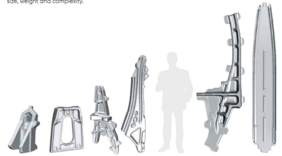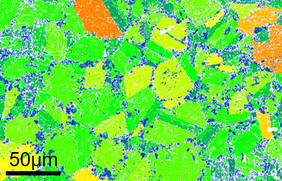Given the fact of the sustainability goals defined by the United Nations, the trend towards increasingly energy- and resource-efficient aircraft is currently more relevant than ever. Steel as a material plays a "supporting" role in the truest sense of the word. Particularly in safety-relevant structural components such as the landing gear or engine mounts, there are hardly any alternatives to this highly resilient and recyclable material. An important parameter in the design of these components is fracture toughness, which is defined as resistance to crack propagation.
Together with its partners, Materials Center Leoben (MCL) is researching strategies to predict the fracture toughness of these highly stressed components, some of which are larger than a human being (Fig. 1), locally and for each manufacturing process with computer support. This enables the partner voestalpine BÖHLER Aerospace GmbH & Co KG on the one hand to make the process more energy and cost efficient, but also to further optimize components in terms of strength and fracture toughness in order to drastically reduce CO2 emissions during aircraft operation. To this end, the team at MCL has developed a model network that describes the complex mechanisms in the microstructure of the steel during different process steps in a spatially resolved manner in the component. The strength and thus the fracture toughness can then be successfully determined from this microstructure using a model that has also been developed with spatial resolution in the component.
This combines complex metallurgical phenomena such as spontaneous recrystallization or austenite stabilization, which were investigated in detail in this project, with the forging process and the resulting properties.
The prediction of spontaneous recrystallization in particular, which takes place without prior deformation, means that the properties can now be accurately predicted. Publications on this topic have been published in internationally renowned journals (Fig. 2).
With the help of the new calculation tool, voestalpine BÖHLER Aerospace GmbH & Co KG can design forging processes for high-strength PH steels in such a way that strict aircraft manufacturer specifications regarding microstructure as well as strength and toughness properties are reliably achieved, even with increasingly complex dimensions.
The simulation tool can already be used in the quotation phase to make reliable statements about the compliance with required specifications and to design optimal sequences of process steps. Efficient process development saves important resources.
The simulation-supported production of large forgings from high-strength PH steels voestalpine BÖHLER Aerospace GmbH & Co KG a leading international position as technology leader in this segment and thus increases its competitiveness. The expansion of the production of complex forgings will lead to an increase in the market volume of the companies involved and thus create new jobs in the region.
-
Project coordination (Story)
Dr. Gerald Ressel
Gruppenleiter Steel Engineering
Materials Center Leoben Forschung GmbH
T +43 (0) 3842 45922-68
gerald.ressel(at)mcl.at
IC-MPPE / COMET-Center
Materials Center Leoben Forschung GmbH
Roseggerstrasse 12
8700 Leoben
T +43 (0) 3842 45922-0
mclburo(at)mcl.at
www.mcl.at
Project partner
• BÖHLER Aerospace GmbH & Co KG, Austria





















